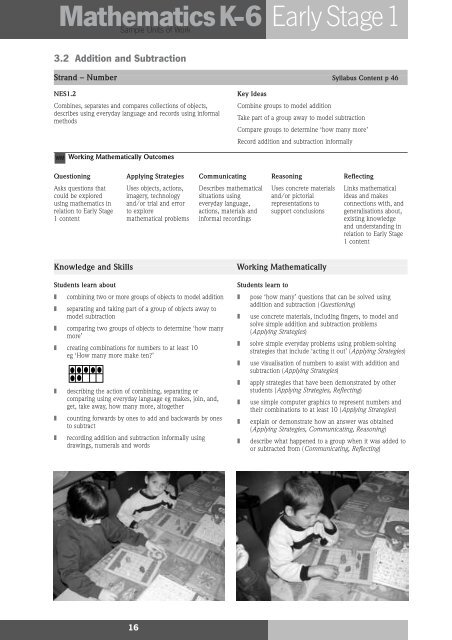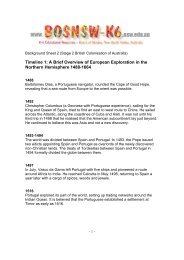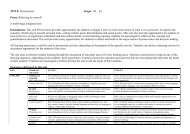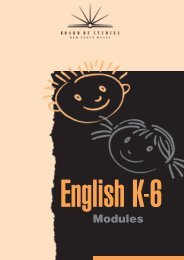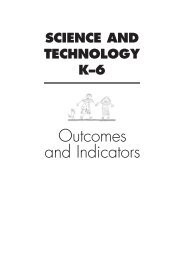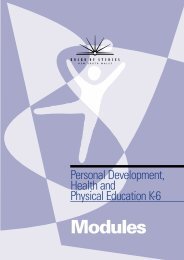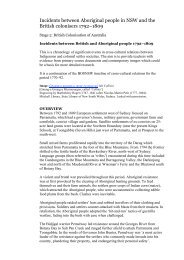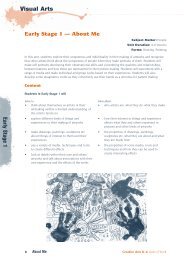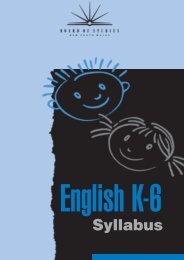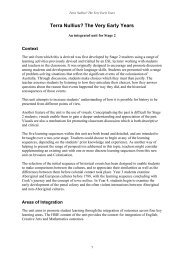Math K-6 WS - K-6 Educational Resources
Math K-6 WS - K-6 Educational Resources
Math K-6 WS - K-6 Educational Resources
Create successful ePaper yourself
Turn your PDF publications into a flip-book with our unique Google optimized e-Paper software.
<strong>Math</strong>ematicsK-6 Early Stage1<br />
3.2 Addition and Subtraction<br />
Strand – Number Syllabus Content p 46<br />
NES1.2<br />
Combines, separates and compares collections of objects,<br />
describes using everyday language and records using informal<br />
methods<br />
WM<br />
Questioning<br />
Asks questions that<br />
could be explored<br />
using mathematics in<br />
relation to Early Stage<br />
1 content<br />
Students learn about<br />
Sample Units of Work<br />
Working <strong>Math</strong>ematically Outcomes<br />
Applying Strategies<br />
Uses objects, actions,<br />
imagery, technology<br />
and/or trial and error<br />
to explore<br />
mathematical problems<br />
❚ combining two or more groups of objects to model addition<br />
❚ separating and taking part of a group of objects away to<br />
model subtraction<br />
❚ comparing two groups of objects to determine ‘how many<br />
more’<br />
❚ creating combinations for numbers to at least 10<br />
eg ‘How many more make ten?’<br />
❚ describing the action of combining, separating or<br />
comparing using everyday language eg makes, join, and,<br />
get, take away, how many more, altogether<br />
❚ counting forwards by ones to add and backwards by ones<br />
to subtract<br />
❚ recording addition and subtraction informally using<br />
drawings, numerals and words<br />
Communicating<br />
Key Ideas<br />
Describes mathematical<br />
situations using<br />
everyday language,<br />
actions, materials and<br />
informal recordings<br />
Combine groups to model addition<br />
Take part of a group away to model subtraction<br />
Compare groups to determine ‘how many more’<br />
Record addition and subtraction informally<br />
Reasoning<br />
Students learn to<br />
Uses concrete materials<br />
and/or pictorial<br />
representations to<br />
support conclusions<br />
Knowledge and Skills Working <strong>Math</strong>ematically<br />
16<br />
Reflecting<br />
Links mathematical<br />
ideas and makes<br />
connections with, and<br />
generalisations about,<br />
existing knowledge<br />
and understanding in<br />
relation to Early Stage<br />
1 content<br />
❚ pose ‘how many’ questions that can be solved using<br />
addition and subtraction (Questioning)<br />
❚ use concrete materials, including fingers, to model and<br />
solve simple addition and subtraction problems<br />
(Applying Strategies)<br />
❚ solve simple everyday problems using problem-solving<br />
strategies that include ‘acting it out’ (Applying Strategies)<br />
❚ use visualisation of numbers to assist with addition and<br />
subtraction (Applying Strategies)<br />
❚ apply strategies that have been demonstrated by other<br />
students (Applying Strategies, Reflecting)<br />
❚ use simple computer graphics to represent numbers and<br />
their combinations to at least 10 (Applying Strategies)<br />
❚ explain or demonstrate how an answer was obtained<br />
(Applying Strategies, Communicating, Reasoning)<br />
❚ describe what happened to a group when it was added to<br />
or subtracted from (Communicating, Reflecting)


